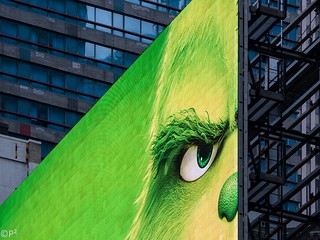“Grinch times square” by The Arch from Flickr.com
Summary
The goal of our film was evoking a sense of unease and tension through aspects of cinematography and music in our silent film. Our film, “How the Gronch Stole Valentines”, was about a pessimistic boy who finds new value in Valentines day when a girl shows bravery and confronts him about his anger towards the day.
21st Century Skills
While we were producing this film, we overcame our challenges by finding ways to communicate and overcome problems through finding creative and simple alternative options. We worked together and used creativity and critical thinking to sort through or tasks and produce a film with the restrictions and requirements impressed on us. our communication was a group chat we could use at any time through SMS and MMS messaging, and our critical thinking was used when we had to fit our entire crew with personal lighting into a small space with limited time, so we had to evaluate what we could cut out of our
The Film
Reactions to Final Version
Reactions from adviser James
“Camera Discovers actors.”
“Negative lighting technique was excellent!”
Reactions from Peer Adviser Silas S
“The lighting was cool!”
This was an evaluation of the lighting which was my main personal goal, and they evaluated it as an excellent choice of visual techniques to resonate with the mood of the film.
Evaluation of Final Version
In our film, we used concrete and emotional story telling, evoking the empathy of the audience to feel for the Gronch who lacked the very basic human need of feeling loved. We kept a strong visual sense of story telling to let the audience feel connected in a way that was more than just observant, letting the camera discover the actors and have long drawn out shots.
What I Learned and Problems I Solved
I had to find a way to orchestrate the team in order to create a seamless Idea that wasn’t all over the place, and make sure we were organized and making good time while getting our takes and edits as close to perfect as possible. Because of this I had to figure out how to communicate with our team such as frequently texting in a group chat to organize us and assure we all have the same idea moving forward. I would help the screenwriter and cinematographer and editor to make the right “look” of film to
